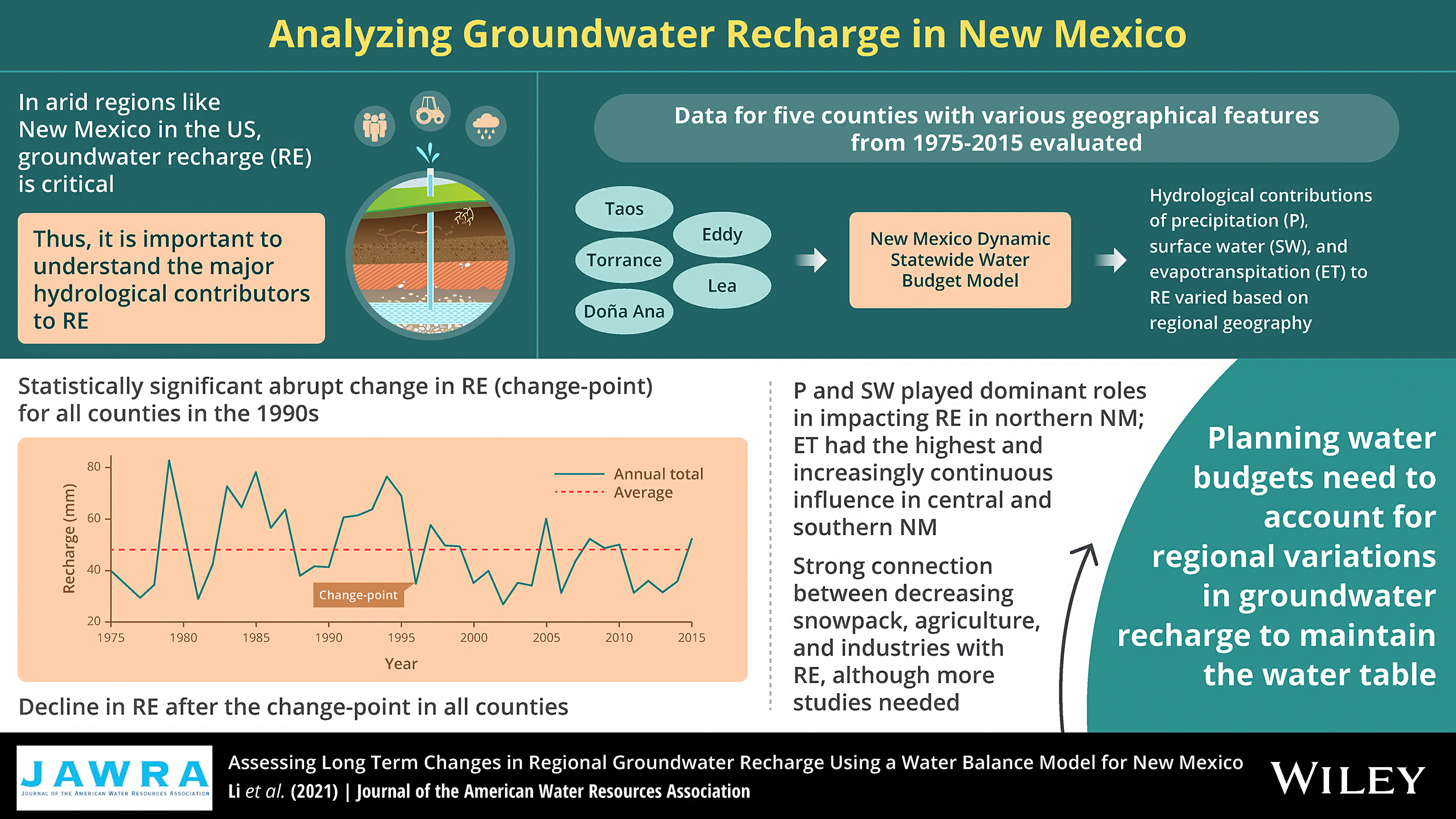Researchers Investigate Long-Term Changes in Regional Groundwater Recharge in New Mexico
By Jeanette Torres, NM WRRI Program Coordinator
As an arid state in the southwestern U.S., New Mexico has long faced issues of water scarcity and the lack of surface water. It is no secret that water is an invaluable resource that sustains not only agricultural industry, but also naturally occurring ecosystems and human livelihood. Many New Mexican families have suffered from the effects of extreme, prolonged drought, and without a sufficient supply of water to meet demands, water use and conservation have become a topic of much debate over the years.
To gain insight into how to improve management and protection of land and water usage around New Mexico, Dr. Xiaojie Li, Dr. Alexander (Sam) G. Fernald, and Dr. Shaozhong Kang, have performed a study exploring the changes in groundwater recharge (RE), precipitation, surface water inflow, outflow, diversions, returns, and surface water and groundwater evapotranspiration in five New Mexico counties (Taos, Torrance, Doña Ana, Eddy, and Lea) during the years between 1975-2015. Monthly and yearly data used in this study were downloaded from the New Mexico Dynamic Statewide Water Budget (NMDSWB) model on the NM WRRI website, which combines observed baseflow water data and hydrological modeling methods to calculate RE based on the water budget approach (RE equals groundwater recharge).
The primary focus of their research paper entitled, Assessing Long-Term Changes in Regional Groundwater Recharge Using a Water Balance Model for New Mexico, was to investigate five critical aspects of groundwater retention, including (1) the variation of groundwater RE over the past 41 years for five counties, (2) the change-point of RE for those five counties, (3) the temporal trend of RE before and after the change-point, (4) the relationship between RE and precipitation, and finally (5) the contribution rates of variables affecting recharge. A change-point refers to the point in time a variable changes significantly, and is widely used to represent hydrological variable mutations. As described in this study, groundwater is an important source of water to be found in New Mexico, and accounts for nearly half of all total annual water withdrawn for all uses.
Upon looking at the collected data for all counties, a major change-point in RE was revealed to have occurred in the 1990s. It was discovered that the quantity of RE in New Mexico is strongly intertwined with the amount of snowmelt/snowpack accumulation, surface water flow, development and expansion of oil and gas industries, and agricultural irrigation events. This provides evidence that both climate fluctuation and human activity greatly impact water instability and RE rate. In order to combat such RE variations, this study suggests water managers should attempt to increase deep percolation under irrigated lands, and improve management of unirrigated landscapes such as forests to minimize evapotranspiration from groundwater. Urban and residential growth should also be closely monitored and optimized to have a net-zero impact on RE. Taking steps towards slowing climate change impacts (e.g. snowpack melting, and alternating fertilizers and pesticides to reduce carbon and nitrogen emissions) could also have a positive impact on RE.
To ensure each county’s RE fluctuation was represented correctly, water budget calculations were performed independently of one another based on available historical data included in the NMDSWB model. RE levels presented by each county show that individual water budgets for each region are important in identifying hydrological differences. Each aspect examined within this study allowed the researchers to see the interconnections between both human and weather activity on groundwater RE. As New Mexico water budgets change and evolve with time, it is imperative that land use, groundwater evapotranspiration, climate change efforts, and agriculture be carefully managed to ensure there is enough water to meet demand for generations to come.
To read the full article illustrating the complete set of efforts undertaken by the research team, please click the link found here .

Infographic illustrating groundwater recharge trends and hydrological contributors in New Mexico between 1975-2015.
